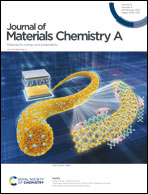Thermally stable fishnet-like 1T-MoS2/CNT heterostructures with improved electrode performance†
Abstract
1T-MoS2 is the metallic phase of molybdenum disulfide (MoS2), and has obvious advantages in energy storage applications compared with the 2H phase. However, the 1T phase is inherently unstable and can be easily converted to the 2H phase, specifically under thermal annealing. So, the 1T phase can hardly be further modified after synthesis, and there is a hidden danger that high boiling point organic solvents or moisture cannot be removed, which will inevitably affect the performance of the material. In this paper, we described a 3-dimensional fishnet-like 1T-MoS2 heterostructure (3D@1T-MoS2), and revealed that the 1T phase MoS2 in the as-synthesized 3D@1T-MoS2 nanostructure is thermally-stable (even at high-temperature: ∼700 °C). Aided by theoretical calculations and XPS deconvolution spectrum analysis, the phase stability mechanism is revealed to be closely related to the presence of carbon nanotubes and graphite carbon in this structure. Remarkably, after high temperature treatment, this 3D@1T-MoS2-700 electrode delivers a large reversible capacity of 5.25 mA h cm−2 (∼1800 mA h g−1) at 0.1 mA cm−2.



 Please wait while we load your content...
Please wait while we load your content...